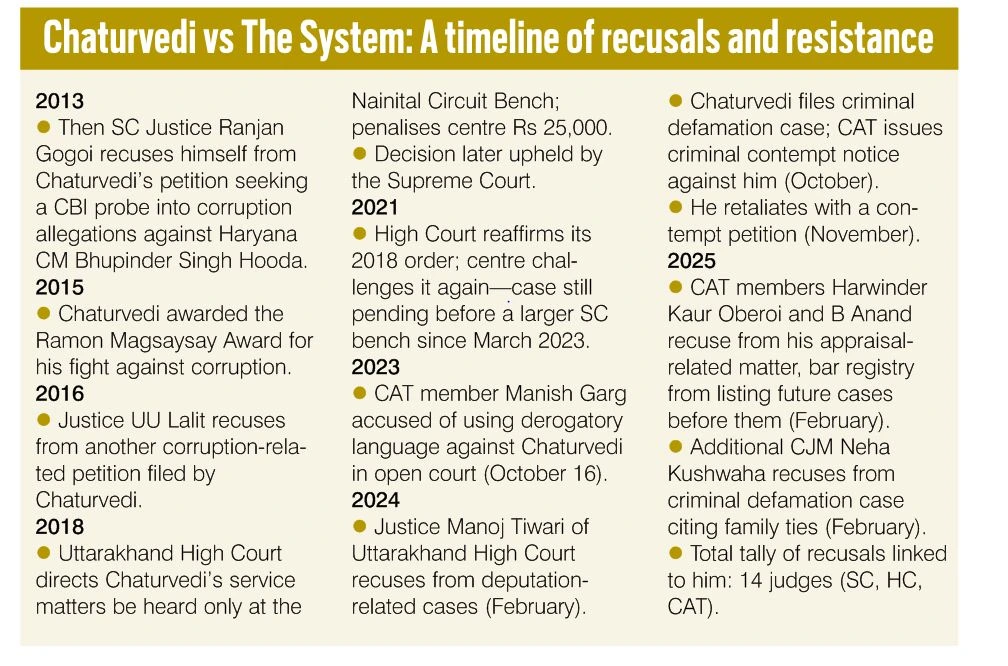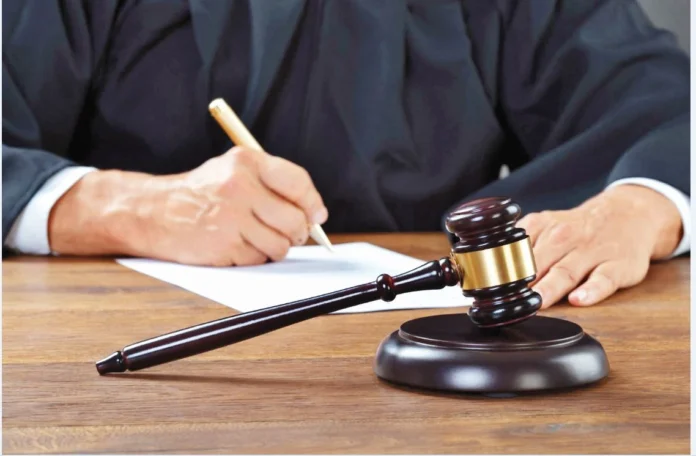By Dilip Bobb
Sanjiv Chaturvedi is a Ramon Magsaysay Award-winning Indian Forest Service officer. He is also a whistleblower against corrupt practices by politicians/bureaucrats. He currently faces a criminal defamation suit in which no less than 14 judges have recused themselves from the case, many offering no reasons for doing so. One who did was Additional Chief Judicial Magistrate Neha Kushwaha of Nainital, who stepped aside from a criminal defamation case filed by Chaturvedi, citing personal reasons linked to familial connections.
Kushwaha stated that she is related to another Central Administrative Tribunal (CAT) member, DS Mehra, who often visits her official residence, a connection she deemed sufficient grounds for her recusal. Mehra’s bench had, in October 2024, issued a criminal contempt notice against Chaturvedi for initiating the defamation case. In retaliation, Chaturvedi filed a contempt petition against Mehra in November 2024. The case concerns allegations by Chaturvedi that CAT member Manish Garg used objectionable language against him in open court on October 16, 2023.

The list of 14 judges who recused themselves includes two Supreme Court justices, two judges of the Nainital High Court, the CAT Chairman, one trial court judge in Shimla, and seven CAT members from benches in Delhi and Allahabad. Chaturvedi was given the prestigious award in 2015 for his anti-corruption efforts. Ten years later, the trend continues.
In February 2025, CAT members Harwinder Kaur Oberoi and B Anand recused themselves from a matter concerning Chaturvedi’s appraisal report without offering any explanation. They also instructed the registry not to list future matters involving him before their bench. A similar step was taken in February 2024 by Uttarakhand High Court Justice Manoj Tiwari in cases related to Chaturvedi’s deputation. In 2018, the Uttarakhand High Court directed that Chaturvedi’s service-related matters be heard exclusively by the Nainital Circuit Bench, penalising the central government Rs 25,000, a decision upheld by the Supreme Court. The High Court reaffirmed this in 2021, prompting another legal challenge by the centre, now pending before a larger Supreme Court bench since March 2023. Earlier recusals include then Supreme Court Justice Ranjan Gogoi in 2013 and Justice UU Lalit in 2016 from a petition filed by Chaturvedi seeking a CBI probe into alleged corruption by then Haryana Chief Minister Bhupinder Singh Hooda and other senior officials. Both stepped aside without citing reasons. The frequency and opacity of these recusals continue to raise concerns about judicial impartiality and access to justice for whistleblowers in India.
Some of the recusals go against the original Latin maxim used to describe recusals, maxim nemo judex in re sua which literally means that no man shall be a judge in his own cause.
The latest case involving a recusal by a judge of the Supreme Court was Justice Vinod Chandran. He recused himself from hearing a PIL seeking a probe against Vedanta group companies on charges of fraud and other financial crimes. He gave no reasons publicly for recusing himself. The bench hearing the case involving a PIL filed by Shakti Bhatia, on September 8, consisted of Chief Justice BR Gawai, Justice Vinod Chandran and AS Chandurkar. That means the matter now shifts to another bench.
Earlier, Justice SH Kapadia while hearing the matter, disclosed the fact that he owns some shares in Vedanta. He asked the lawyers appearing in the case whether he should recuse himself from hearing the case if the lawyers had any objections. They allowed him to carry on hearing the matter. In Justice Chandran’s case, this was the second recusal in the same week. He had recused himself in a case involving a challenge to the appointment of Professor Naima Khatoon as the first woman vice-chancellor of Aligarh Muslim University. This time, Justice Chandran recused himself on the grounds that when he was chief justice of the Patna High Court, he was involved in the appointment of one of the petitioners as vice-chancellor of Chanakya National Law University in Patna. In the case, the bench also comprised Chief Justice of India BR Gawai.
Another recusal by a judge of the top court has also led to avoidable delays. On August 26, Justice MM Sundresh suddenly and inexplicably recused himself from a case filed by activist and advocate Surendra Pundalik Gadling in the Surjagarh iron ore mine arson case of 2016. The case, involving a bail plea, had been with Justice Sundresh’s bench since July 9, 2024. For well over a year, the case had seen 13 adjournments till the day of the judge’s recusal, on August 26. The adjournments were largely due to the government seeking more time to file a counter-affidavit. Gadling has been in jail for over six years now. Again, with the judge’s sudden recusal, the matter will now shift to another bench.
There are essentially two kinds of recusal. One is an automatic recusal, where a judge himself withdraws from the case. The second is when one of the parties involved points to possible bias or personal interest of the judge in the case and requests a recusal. In most cases, judge recusals are voluntary withdrawals from a legal case by a judge to uphold judicial impartiality, typically due to a conflict of interest, personal bias, or prior involvement with a party or subject matter of the case. The process ensures the integrity of the justice system by preventing any perception of bias and follows the principle that “no one can be a judge in their own case”.
In India, the prerogative of recusal is vested in the judge. No judge can be forced to withdraw from a case by another party. However, it is the duty of the bench and the bar to know why a judge has been recused from a specific matter. There has to be a requirement of statutory obligation on the judges to inform the litigants as to why there is a decision to recuse from hearing. Recusal, as most legal experts have pointed out, should be used sparingly.
Only once has recusal involved a chief justice. This was the case of alleged sexual harassment raised against Chief Justice Ranjan Gogoi in which Justice NV Ramana recused himself, declaring: “My decision to recuse is only based on an intent to avoid any suspicion that this institution will not conduct itself in keeping with the highest extraordinary nature of the complaint, and the evolving circumstances and discourse that underlie my decision to recuse and not the grounds cited by the complainant per se. Let my recusal be a clear message to the nation that there should be no fears about probity in our institution, and that we will not refrain from going to any extent to protect the trust reposed in us.”
Examples of judges recusing themselves in prominent cases include:
- Ayodhya-Ram Janmabhoomi case: Justice UU Lalit recused himself from the Constitution bench hearing the Ayodhya land dispute case because the litigants pointed out that he had previously appeared as a lawyer in a criminal case that was connected to the matter.
- Bilkis Bano case: Supreme Court Justice Bela M Trivedi recused herself from hearing Bilkis Bano’s plea related to the release of prisoners in a rape case. While no specific reasons were given, her past work as Law Secretary to the Gujarat government was believed to be a factor.
- Bhima Koregaon case: Five judges of the Bombay High Court recused themselves from hearing cases related to the Bhima Koregaon violence without providing explicit reasons.
Some judges have declined to recuse themselves when there is clearly a conflict of interest. One such case was the demand for recusal of Justice Arun Mishra from a land acquisition case in Indore. The judgment came under scrutiny since he was also the presiding judge for the review committee. Despite that, he refused to recuse himself. He stated: “No litigant can choose who should be on the Bench. He cannot say that a judge who might have decided a case on a particular issue, which may go against his interest, should not hear his case as part of the larger Bench.”
That was against the stand taken by the Supreme Court in a case related to the appointment of M Nageswara Rao as the Interim Director of CBI. Three Supreme Court judges recused themselves. CJI Ranjan Gogoi recused himself because he was the part of the selection committee. Justice AK Sikri recused himself because he was a member of the panel which removed the previous director of the CBI. Justice NV Ramana recused himself based on a personal reason; he had attended the wedding ceremony of the daughter of M Nageswara Rao.
That no one shall be a judge in his/her own cause is the gold standard for recusals, but as many of the instances cited reveal, the flaw in the judicial system is when the public is given confusing signals about whether judges must reveal why they choose to walk out of cases.
—The writer is former Senior Managing Editor, India Legal magazine


